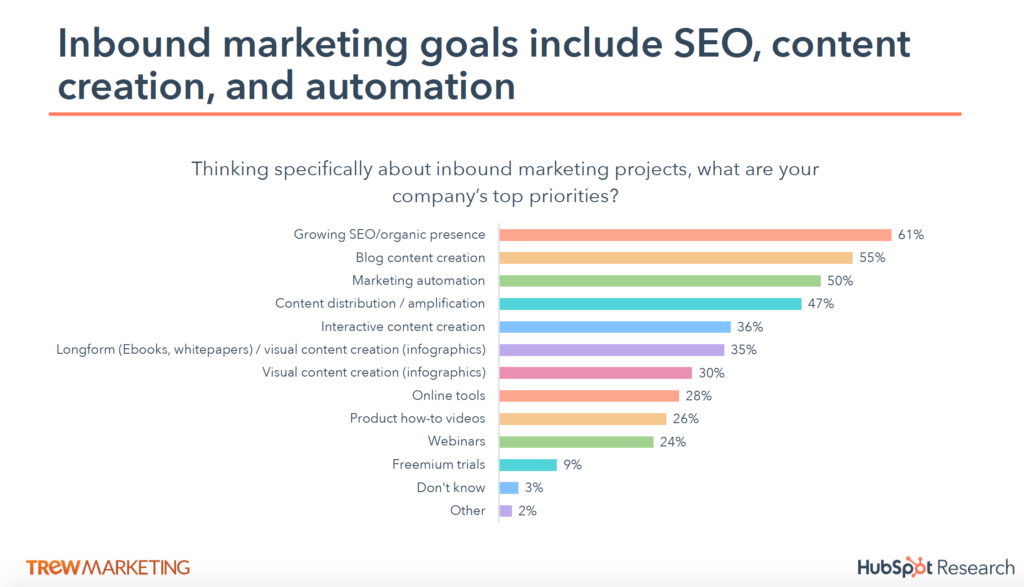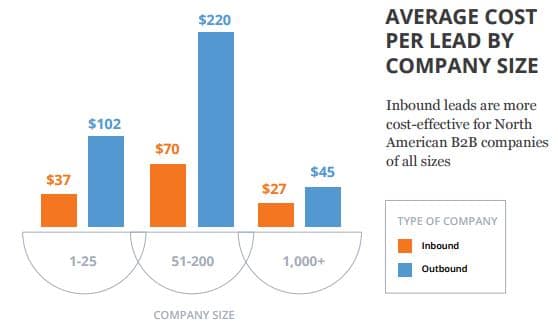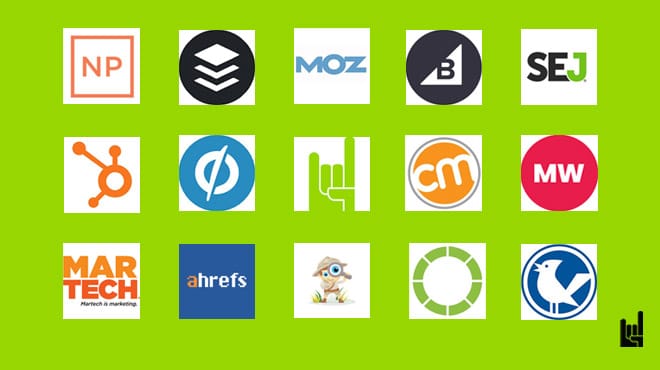At first glance, they might seem like two sides of the same coin – but are they really? What do these terms actually mean, and how do their pros and cons stack up?
Let’s break it all down.
What Is Outbound Marketing?
Outbound marketing is a form of marketing that reaches out to its target audience to make them interested in buying your product or service.
It’s a one-way conversation that generally centers on the product/ service and why the audience should buy it. Outbound marketing includes most of the pre-Internet-era marketing activities and some of the digital ones.
Some common examples of outbound marketing include:
- Traditional media (TV, Radio, Print)
- Press releases
- Cold email outreach
- Pop-ups & pop-unders
- Billboards
- Video ads
- PPC (can be inbound marketing as well)

The Benefits of Outbound Marketing
There are several advantages to outbound marketing that you should not overlook.
1. Volume & speed
The main benefit of outbound marketing is that it allows you to reach a large audience in one shot.
With outbound marketing, you basically pay to use already established marketing channels, where the majority of the population is.
2. Fast results
Outbound marketing may produce fast results.
As soon as your campaign is ready, you can bring it in front of your audience and make a sale.
3. Brand awareness
Outbound marketing increases brand awareness by enabling you to connect with people who haven’t heard of your products or services before.
Outbound marketing works great for the top of your marketing funnel.
4. Supports your inbound efforts
An outbound marketing strategy can complement your inbound marketing strategy.
From boosting well-performing posts to creating display ads on relevant platforms, promotion can work as a lubricant for your inbound marketing machine.
The Challenges of Outbound Marketing
Outbound marketing is a challenge to execute well. The following are some of the disadvantages of utilizing an outbound marketing strategy.
1. Acquiring leads can be more expensive
Outbound marketing usually comes at a bigger cost. Running ads, buying media space, finding emails, and cold calling are all pretty expensive.
Even if you’ve paid for everything, there’s no assurance your target audience will respond to your ad the way you want them to.
2. Outbound marketing efforts are more opposed
When it comes to developing an effective outbound marketing campaign, it’s vital not to go overboard.
The reason is that many people dislike having a business or company’s promotional efforts pushed upon them. In fact, if your outbound marketing campaign is too aggressive, it may have the opposite of its intended impact and end up turning customers off.
3. Customers aren’t easily attracted
People learn to research for themselves rather than be dictated by advertisements. They prefer discovering things for themselves (or at least have the impression they do).
Also, since outbound marketing is broader, it’s also difficult to make it appealing and relevant to everyone.
4. Advertising saturation
One of the most significant drawbacks of outbound marketing is that people nowadays pay less attention to advertisements in general.
People are avoiding advertising, whether by unsubscribing to email lists, blocking cold calls, avoiding websites with too many advertisements, fast-forwarding TV commercials, or not opening posts or emails.
5. It’s difficult to get feedback
Outbound marketing is primarily a one-way communication mechanism in which you are sending promotional materials to potential consumers, but have no real possibilities to engage with your target audience.
To learn how people react to your advertisements, you must organize focus groups and conduct surveys to get in-depth feedback.
What Is Inbound Marketing?
Inbound marketing is a company’s approach to attracting consumers by creating useful content and experiences that are specific to them.
Inbound marketing is like a magnet. Instead of sending out general messages to uninterested audiences, inbound marketing is about serving answers and solutions to specific questions and needs to already interested prospects.
Some common examples of inbound marketing include:
- Blog posts & articles (like this one!)
- SEO
- Explainer videos – video content
- Webinars
- Opt-in email lists
- Earned social media
- Influencer outreach
- eBooks

The Benefits of Inbound Marketing
Here are some key benefits of inbound marketing:
1. Quality traffic and leads
With a more targeted and informed approach, you can attract leads who are more likely to be interested in your services.
Which brings us to the next point.
2. Reduced cost
Your company may save money and achieve a greater return on investment with an inbound marketing budget that is more targeted.
3. Higher trust and credibility
When you give consumers the option to do their own research and discover you organically, they perceive you as more trustworthy.
Inbound marketing tactics such as providing useful content and leveraging social proof also reduce customers’ concerns about your brand’s safety.
4. Opportunity to learn and evolve
Inbound marketing allows you to understand how to make your products and services better by engaging with customers on social media and listening to their discussions, inquiries, and feedback.
5. Pushes users down the funnel
Inbound marketing isn’t only about obtaining new happy consumers.
It’s also about keeping them satisfied (Retention), so much so they’d happily promote your business on their own (Referral).
The Challenges of Inbound Marketing
A lot of businesses are turning to inbound marketing strategies to improve exposure and acquire new consumers because it’s more cost-effective and less intrusive from the perspective of potential clients.
However, despite its apparent simplicity, inbound marketing isn’t very straightforward. In fact, inbound marketing requires a whole new strategy and approach to business in order for an organization to achieve success in this area.
Let’s take a look at five of the most significant inbound marketing challenges.
1. You need a well-planned strategy
It requires a lot of preparation and research because the goal of inbound marketing is to attract targeted and qualified leads and consumers.
If you’re starting a blog, for example, you’ll need a thorough content plan that includes persona mapping, buyer journey topics, and keyword research.
2. It’s labor-intensive
The process of creating a website, maintaining social media accounts, sending emails to properly segmented lists, producing engaging videos, and other inbound methods all takes time.
You’ll need either a strong team or a reliable inbound agency to handle these jobs for you.
3. It requires an optimized website
Your website is the core component of your inbound marketing strategy.
Creating a professionally designed, user-friendly, conversion-optimized website needs a lot of effort and technical know-how.
4. Results take time
You can’t expect to acquire new clients and make a profit in a short time by employing inbound methods
It takes weeks or even months for inbound techniques to pay off your hard work.
Inbound vs Outbound Marketing
In inbound marketing, you interact with the customer before you even know whether they are interested in what you want to sell or not. In outbound marketing, you provide. digital content targeted at specific audiences, written to help solve customers’ problems.
So, what’s more effective, inbound or outbound marketing?
Is this one of these questions that put you in a dilemma when, in reality, both options are correct and viable? Almost.
Indeed, both of these tactics have their own set of benefits and drawbacks. Most businesses discover that combining both approaches is the most successful way to work.
Inbound marketing is the most effective long-term strategy, but it’s unlikely to result in a large increase in revenue right away. Outbound marketing, on the other hand, can help you get new clients quickly, but there are diminishing returns.

If we could sum up both strategies in 2 sentences, it would look like this –
Outbound marketing is great for targeting with your campaigns a huge audience that doesn’t know you – and fast.
Inbound marketing is great for getting users to like you through the information, resources, and tools you provide.
Conclusion
The main benefit of implementing an inbound marketing strategy is that it will not only save you money in the long run but also generate more leads than outbound tactics.
As growth marketers, we know the power of inbound marketing firsthand. After all, successful SaaS products like Dropbox, Slack, and Canva didn’t scale and succeed with outbound marketing but rather with inbound marketing.
If you need help with your overall strategy or you are looking to build an inbound marketing stack, see how we can help you with your Inbound Marketing. You can also reach out to us directly – just contact us here!
Was this article useful?

I write for GrowthRocks, one of the top growth hacking agencies. For some mysterious reason, I write on the internet yet I’m not a vegan, I don’t do yoga and I don’t drink smoothies.



